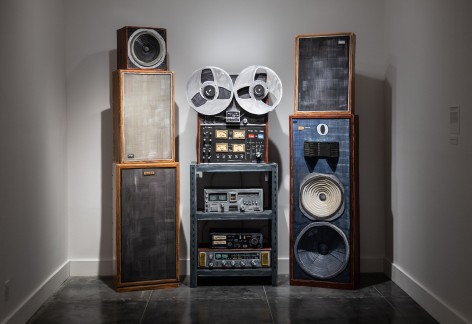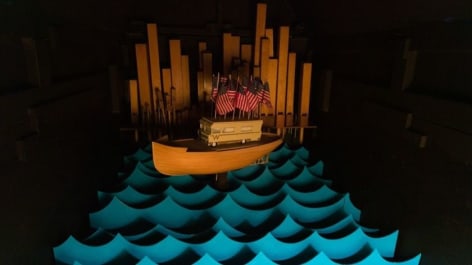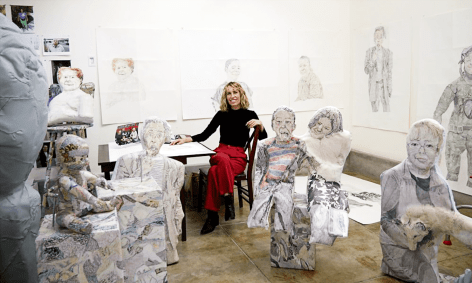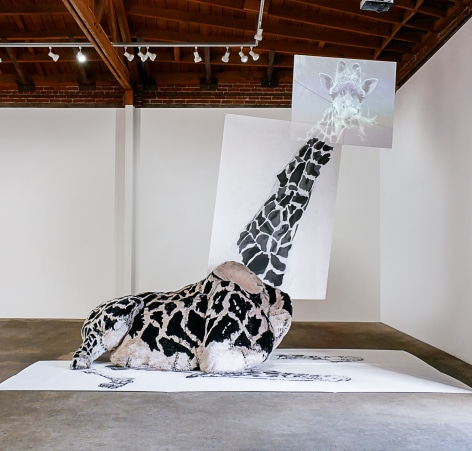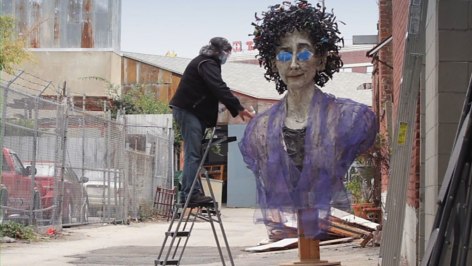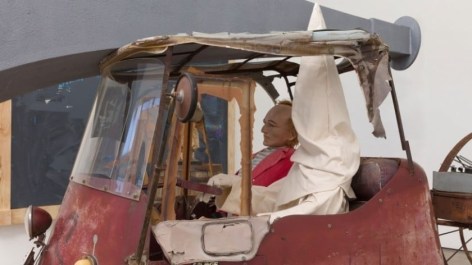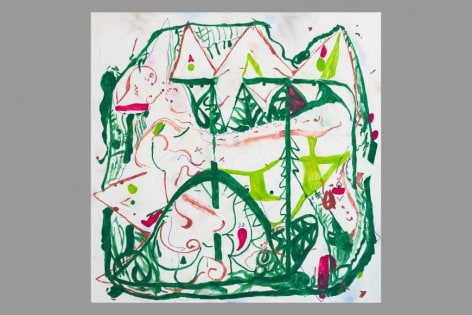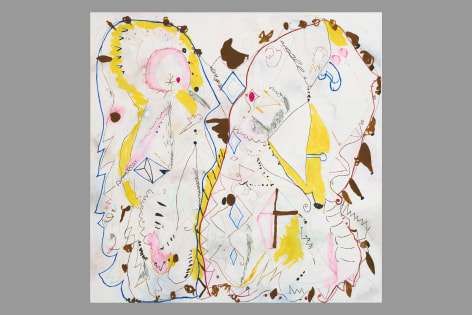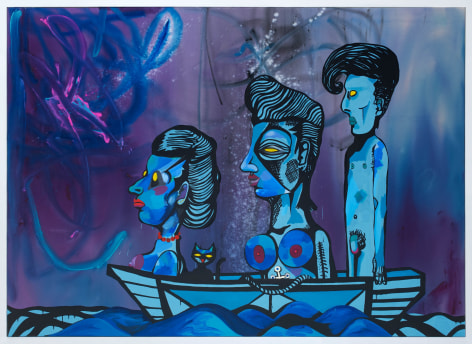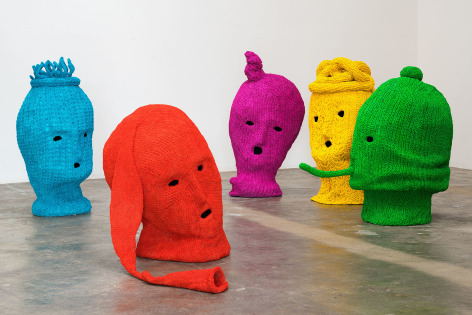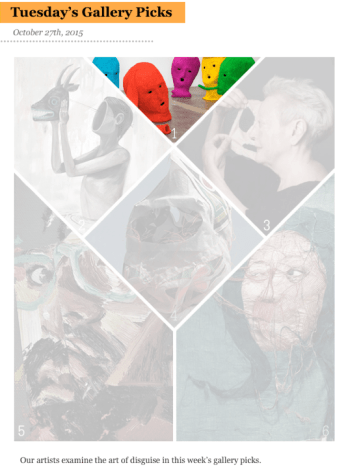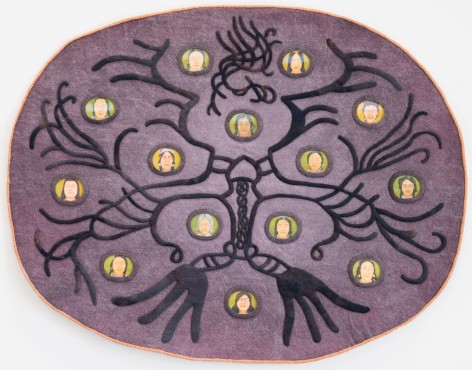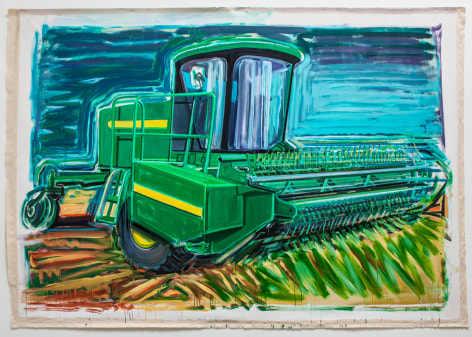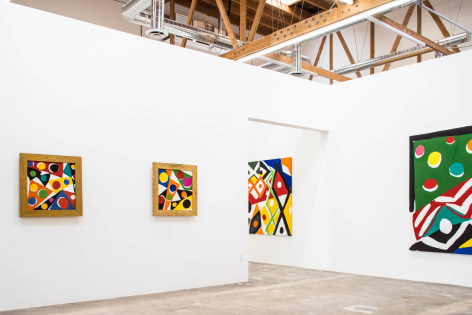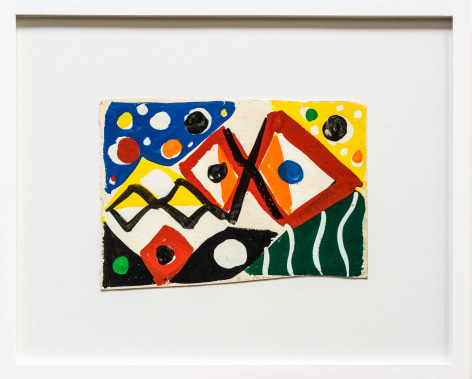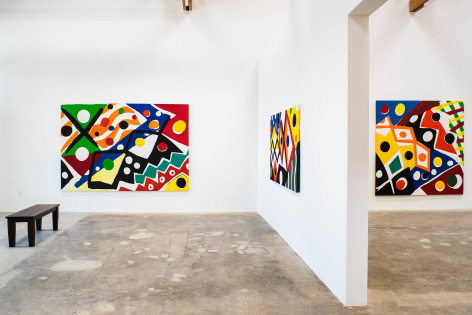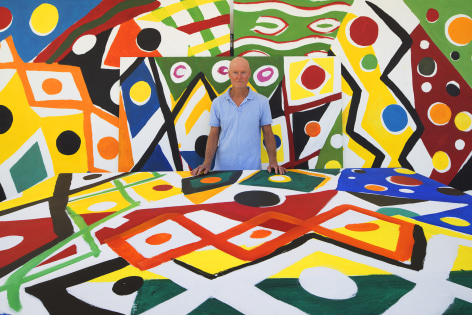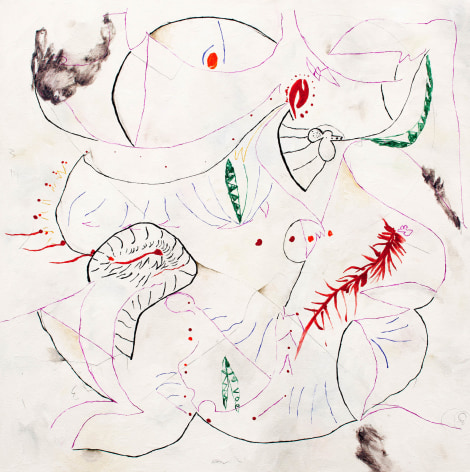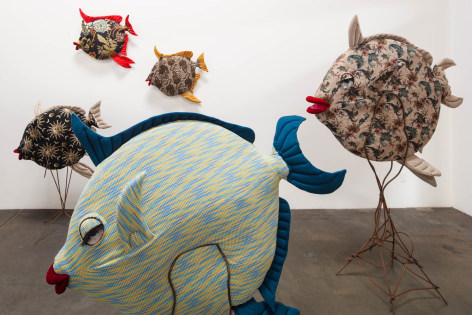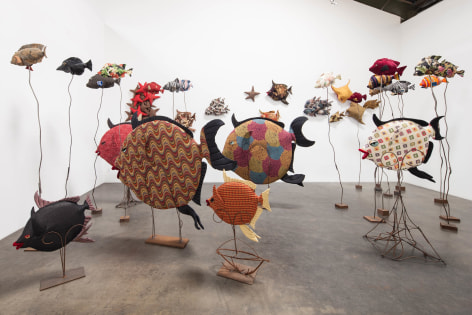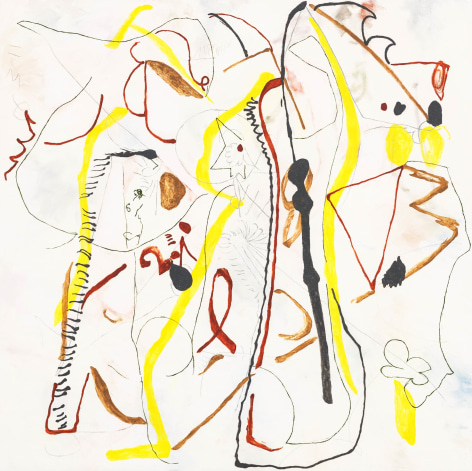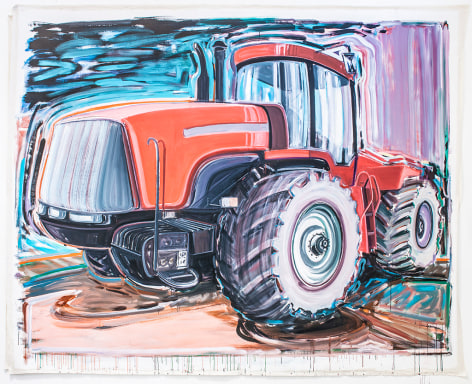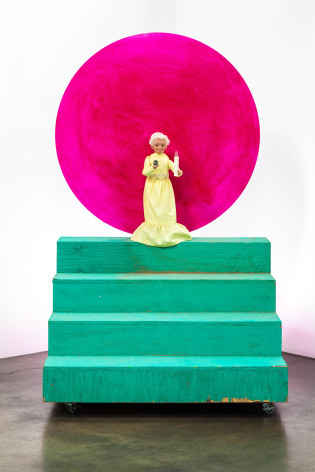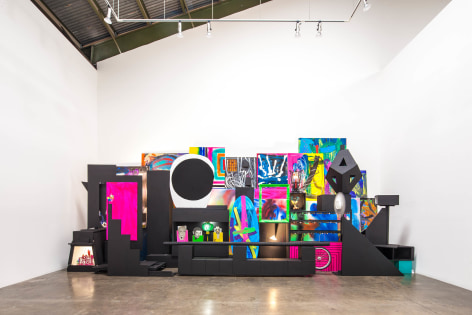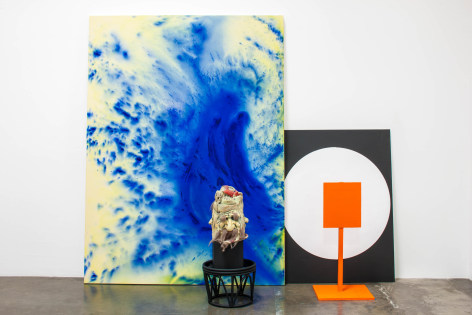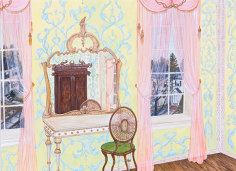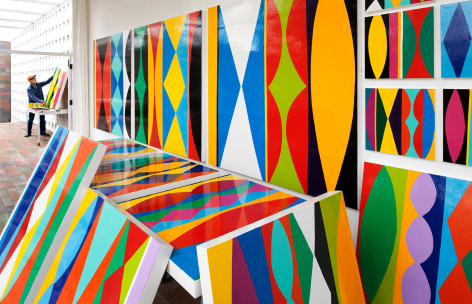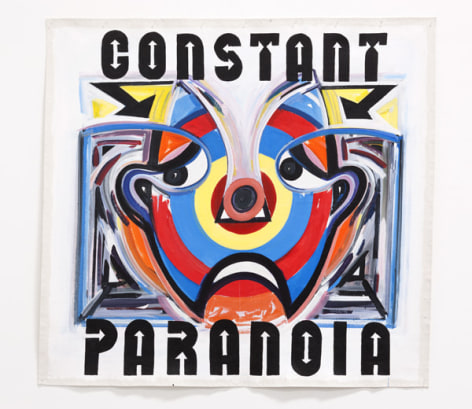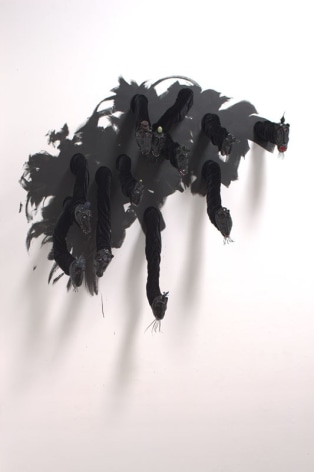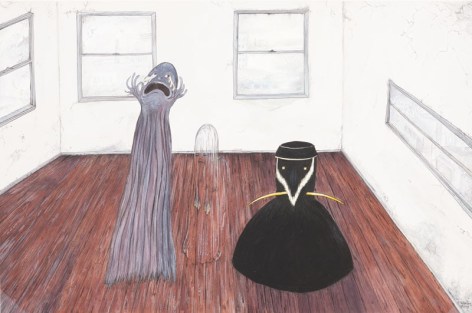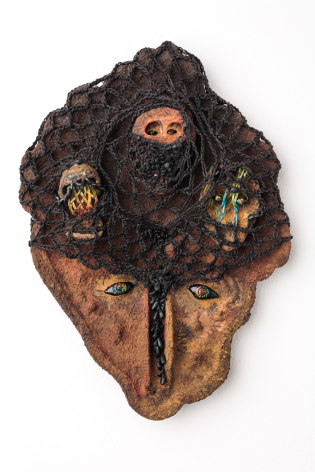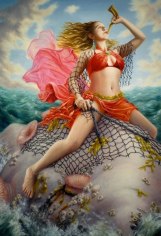POW!: Jean Lowe’s Your Place in the Multiverse aims to make audiences laugh while hitting them with some hard truths about American culture
Hidden in the back corner of Jean Lowe’s installation at the Laguna Art Museum – so concealed it’s easy to miss – is a piece entitled “Town Crier (Self Portrait as Analog).” The 86”x 79” acrylic and cardboard tower mimics an analog reel-to-reel sound system with multiple amplifiers. The audio system is something from the 1970s, meaning it’s dated and obsolete. It’s also silent.
“Town Crier” is a companion piece to “Garden Carpet,” which hangs at the opposite corner of the room. Painted on cloth mache, the 95” x 77” inch rug looks like a faithful representation of a traditional Heriz carpet.
The two parts of Lowe’s “self-portrait” are both a bit puzzling and wholly intentional. “If the carpet expresses my interest in craft, decoration and beauty, then the amp and reel-to-reel is about broadcasting ideas. That’s how I consider my job as an artist: craft on the one hand and content on the other,” Lowe said. “Do I ever question the efficacy of visual arts to stir up conversation? Yes, perhaps, given that ‘Town Crier’ is basically mute and vintage. But, ultimately, visual art is a language and really can be used to talk about anything – and provoking conversation is what I hope to do.”
Your Place in the Multiverse stirs up plenty of conversation. The five-part installation – which occupies the entire lower floor of the Museum – tackles capitalism, consumerism, feminism, environmentalism, animal rights and the bizarre value we place on ephemera, all while making us laugh out loud (and offering free snacks!).
“I use humor to grease the way for serious content, which probably won’t be immediately apparent,” Lowe said. “But as you move through the exhibition, you might start to get a few stab wounds while you’re laughing.”
In addition to her full-scale carpets and elaborate sound system, Lowe creates room-sized furniture installations out of papier-mâché, cardboard, cordwood armatures and enamel paint. Bookcases, a grand piano and even a humorous recreation of a Dollar Store shopping experience known as “Discount Barn” (complete with retail shelves and floor displays) are only part of the show. The exhibition includes samples of Lowe’s work over the past 17 years, showcasing several of her most important installations as well as some new work.
Visitors enter the exhibition through “Discount Barn,” Lowe’s interpretation of America’s ubiquitous big box store. Think Walmart with a sarcastic twist. There’s a floor-to-ceiling display of a fictional product called “Tear Stains Be Gone.” The accompanying advertisement reminds us that, “Being human is hard, but it doesn’t have to look that way!” There are products to trim our waists and sculpt our abs sitting alongside boxes of sugar, Karo corn syrup, cookies and Coors Light. For every piece of merchandise that promises to make us look good is some high-calorie commodity that offers to make us feel good (at least temporarily).
“Discount Barn” offers an array of replicas of everyday consumer products, each one actually for sale
There’s a reason phrases like “retail therapy” and “comfort buys” have permeated our consumer culture. Shopping is seductive. It promises to cure our problems, or at least anesthetize our angst. ‘
“‘Discount Barn’ is an active retail environment,” Lowe said. Meaning the items are, in fact, for sale. Canned goods, almond cookies and “Tear Stains Be Gone” will each set you back $199. A six-pack of Coors Light is a bargain at $499.
“It’s not about making bank,” said Lowe. “It’s about getting the viewer involved in the content of the show. One of the overall themes is how we assign value to stuff.” It’s also about how we express ourselves through the purchases we make. It’s a challenge to walk through the exhibit and not ponder, at least for a moment, whether it’s worth $199 to take home an artistic memento. And once you ask yourself the question, you’re complicit in Lowe’s artistic point. Zing!
“It’s a critique of the consuming part of consumerism,” said Lowe. “To make that critique, I made a whole bunch of stuff that can be purchased, so there’s a lot of inner tension in the conflicting stuff going on.”
If you do decide to make a purchase (and several people have), an apron-clad associate sits at a sales booth, waiting to take your credit card. A facsimile of a boombox spews out loud and cheerful Muzak beside her. I initially mistook one of the sales associates, Emma Yervandyan, as a mannequin and part of the fabricated exhibit. Apparently, I wasn’t the first. “People often think I’m not real,” Yervandyan told me. “Almost every other person who comes in thinks I’m not real. When I look up, they get scared. I don’t think I look like papier-mâché. But it’s this environment. It’s such a surreal setting that you assume nothing’s real.”
Look closely and notice even the fire extinguisher on the wall is a painted replica.
POW! – “Portraits of Women”
In the room adjacent to “Discount Barn,” visitors will discover “POW! (Portraits of Women).” Or, Lowe told me, “The acronym could also be ‘Prisoners of War’ or a cartoon reference. But, really, it’s ‘Portraits of Women.’”
“Portraits of Women” contains seven temporary portraits, painted directly on the Museum’s wall, as a commentary on the depictions of women by modernist male painters
The Pepto-pink room contains seven portraits, each one hand painted onto the Museum’s wall. Even the frames around the portraits are painted on the wall, making each portrait ephemeral. Does that bother Lowe? Not at all. “That’s very much part of the purpose of this room. That’s what gives it power,” she said. “There are no souvenirs. That’s part of what drives my subject matter. Because I am attached to things, but I don’t like it. But I totally am attached to stuff.
“For ‘Portraits of Women,’ I specifically wanted to do a show that didn’t have any objects, didn’t have stuff that I collected. No merch. That was the idea,” Lowe said. “I was interested in thinking about depictions of women by modernist male painters [specifically Jackson Pollock, Pablo Picasso, Willem De Kooning and Francis Bacon] as these fierce, crazy hags. I went into the piece with that in mind. But spending time with each of the paintings, I came to appreciate the strength and power of how these ladies were depicted. It’s nice when I can surprise myself.”
The Baby Grand Piano
Lowe’s pièce de resistance is arguably the baby grand piano which takes up the majority of the central room. The 2006 piece is constructed from enamel, fiberglass, foamboard and cardboard. It sits on another of Lowe’s signature Heriz carpets, accompanied by a fabricated indoor houseplant.
Best of all, the lid is propped open and the soundboard is filled with snack-sized bags of Doritos, Cheetos, Fritos and cans of soda – all free for the taking. “A grand piano is an instrument that signals class and taste,” said Lowe. “Here I’ve reduced it to being a cooler serving chips and drinks. It’s high brought low, and the piano offers up immediate gratification as a snack dispenser. I actually built ‘Baby Grand’ to be able to hold ice and serve beverages cold.”
“Baby Grand,” which functions as a working ice chest to dispense free snacks, comments on objects we deem high-brow and valuable
Lowe has been heavily influenced by the decorative arts movement, especially from the 18th century. “The excessiveness seemed like a reasonable parallel to contemporary society. I’m very issue driven, so I like figuring out what period of decoration would make sense to carry a particular issue.”
Lowe said she’s also been moved by Bernini’s sculptures because they draw you into the action. “Charles Ray sculptures do that too,” she said. “That’s why I like doing installations. I like the way an audience can interact with the pieces.”
Lost Time
As if to punctuate her point on the arbitrary monetary value we assign to seemingly worthless things, Lowe presents an auction house of random ephemera. Old drivers’ licenses, an airsickness bag, an expired phonebook, doctors’ notes scribbled on yellow pads. What will people pay for old scraps of paper? In reality, quite a lot. Visit a few online auction websites to see for yourself. There’s good money in vintage postcards, old broadsides and handwritten letters. Lowe took it to the extreme and offered up some ridiculous (and, of course, humorous)…well…crap.
“Lost Time” features several pieces of ephemera scheduled for auction. It comments both on the passage of time and the random value we assign to seemingly worthless pieces of paper.
“It’s just kind of nonsense stuff, but here value has been ascribed or estimated and these items are all due to be on the chopping block,” said Lowe. “Objects like the phone book are things of the past. So, this installation is both about the passage of time and aging, as well as how we create and assign value.”
Bookshelf Prints
Don’t miss the small library that lies in an alcove near the back. Six separate display shelves house genres common in bookstores – “Women’s Health and Wellness,” “Nonfiction,” “Men’s Interest,” “Food and Wine,” “Reference” and “Motivation and Self Help.” Lowe has been creating faux book covers over the past 30 years. The combination of images and titles will give viewers a chuckle – and then make them squirm.
Bookshelf Prints” represents 30 years of making humorous book titles that comment on the pathos of contemporary American culture
Anxiety: The Unexploited Weight Loss Tool appears alongside Contemporary Genocide in Perspective. Irritable Bridal Syndrome sits next to Sugarmommy: How and Why. Draw your own conclusions about the cover art accompanying Achieve and Maintain a More Powerful Daydream.
Move over to Motivation and Self-Help and you’ll find titles like Ignorance Means Never Having to Say You’re Sorry and Pharmaceutical Solutions to Loneliness (published by Pfizer). The Men’s Interest section includes Essays on Modesty and Hot Buttered Cop Porn.
“I like the juxtaposition of image and text and employing humor in a provocative way to discuss social issues in a really circuitous fashion,” said Lowe.
Last Call,” another series in the exhibit, consists of five paintings that represent pages, or covers, from catalogs for miscellaneous goods. Inspired by Dr. Leonard’s Health and Wellness catalog, Lowe found its inherent oddness difficult to satirize. It’s a humorous comment on our culture’s obsession with consumerism.
LAM’s newly appointed Curatorial Fellow Rochelle Steiner interviewed Lowe at the opening reception on March 19. Steiner said of the exhibition, “Jean’s art is funny, insightful and provocative. She asks us to examine what appear to be consumer products and familiar aspects from the world around us, only to realize that nothing is exactly as it seems. Each of her objects and installations are hand-crafted and she injected them with her unique – sometimes sardonic – wit. The more we look and read, the more we encounter Jean’s perspective on the strange, funny and sometimes sad ironies of the human condition.”
“Girl Boy” (2008) shows Lowe’s love of juxtaposing over-the-top rococo décor with over-the-top contemporary over-consumption
I’ve visited Lowe’s installation three times in the past few weeks, each time discovering something new. Taking time to read her ephemera pays dividends. There are many humorous gems buried in the text. She’s right, though, about suffering some stab wounds along the way. The humor hits hard because it’s filled with truths about human nature – our bottomless desires, our insatiable appetite for consumption, our casual mistreatment of others and our often cruel treatment of animals (be sure to visit the space beyond “Power of Women” for a dose of animal rights reality).
There’s a title buried in Lowe’s “Food and Wine” bookshelf – The Battered Women’s Cookbook. The cover art is a crude color sketch of a tasty looking steak and potato meal with a glistening knife ready to cut into the meat. It might elicit a spontaneous laugh, but it soon leaves you feeling a little sick.
I asked Lowe about her humor and where it comes from. She simply responded: “Humor comes out of pathos.” Fortunately for Lowe, and unfortunate for the rest of us, the world serves up a bottomless supply of inspiration.
Your Place in the Multiverse will be on display at the Laguna Art Museum through September 18. For more information about the exhibit, ticket information and hours, visit the Museum’s website at www.lagunaartmuseum.org.

